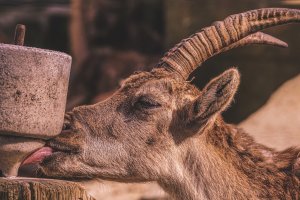Salt licks for pets and livestock – why use them?
If you are a farmer or livestock owner, you know how important it is to provide your animals with proper nutrition and care. The same goes if you are a small pet owner. One often overlooked aspect of animal health is the use of salt licks. Salt licks are blocks of salt that are specifically designed for animals to lick and consume. Though it may seem like a small detail, the benefits of using salt licks for your pets and livestock are numerous. Not only do they provide essential minerals that are often lacking but they also promote hydration and assist with digestion. Additionally, salt licks can help reduce stress and boredom in animals, leading to happier and healthier animals overall. So if you want to ensure that your animals are receiving the best possible care, consider incorporating salt licks into their daily routine.
Note: Salt licks can be a suitable addition to the diet of certain small pets, especially rodents like guinea pigs, hamsters, and gerbils. They contain essential minerals like sodium and calcium, which are necessary for their well-being. However, it’s essential to provide a salt lick specifically designed for small pets and not use the ones made for larger animals like horses. Small pets should consume salt in moderation, so monitor their intake to ensure they don’t overdo it. Always consult with a vet or do some research to determine if a salt lick is appropriate for your particular pet. Different species have varying dietary needs.
What is a salt lick?
Basically a salt lick is a block of salt which you hang by a rope so that the pets and livestock can easily access it. The salt lick is made from slabs of Himalayan salt. They contain 84 natural trace minerals which is the source of the salt. They come in a range of different shapes and sizes, such as compressed salt blocks, round shapes, and large blocks for cattle. You can also purchase mounted holders which you drop the block into allowing larger animals, such as deer, horses, and cows, to access them easily.
Are salt licks all the same?
There are actually a few different salt licks to choose from with each offering something slightly different. The main ones to choose from are Himalayan, red or white.
If your animal has never had a salt lick before then consider starting them on a white lick. The white lick contains sodium chloride.
A red lick contains minerals such as copper, cobalt, iron, iodine and manganese. If your animal is already on a balanced diet they may not require these additional minerals. Always check what is included in their diet before you offer them a red lick.
Himalayan salt licks are made from salt blocks from the Himalayan salt ranges in the Punjab region of Pakistan. They contain 84 trace minerals including high levels of calcium. Again check what your pets and animals are getting in their current diet before introducing additional salts to them.
Why do animals need salt licks?
Animals, like humans, have a craving for salt, and whilst they will normally find some within the other foods that they eat it may be necessary to supplement salt in their diet.
Containing a mixture of sodium, calcium, magnesium and other trace minerals salt licks are ideal as a salt supplement for your animal’s diet. Salt licks are a source of natural pure salt which will help maintain bones, muscles, and both nervous and circulatory systems.
Why use a Salt lick
Salt licks contain trace minerals including calcium which is required for the development of strong bones within both the skeleton of your pet and also their teeth.
There are many other important minerals within the salt licks including magnesium, selenium, sodium, chlorine, and phosphorus. These minerals are important in helping promote the healthy development of the animals.
Think of them as nature’s natural health supplement for small pets, animals and cattle.
FAQs
Are salt licks good for pet rats?
Overall, while salt licks are marketed for small pets like rats, they’re generally not recommended for a balanced diet. A high-quality commercial food and occasional healthy treats are a better way to ensure your pet rats get the nutrients they need without the risk of overconsumption. However salt licks can provide some essential minerals like sodium and calcium, which might be lacking in a pet rat’s diet if it’s not perfectly balanced. Also, the act of gnawing on the salt lick can provide some mental stimulation and enrichment for your rats, helping to curb boredom.
Are salt licks OK for dogs?
Salt licks are generally not recommended for dogs as a complete and balanced dog food should already contain enough sodium for most healthy dogs. Note: Excessive sodium intake can actually be harmful for dogs. Just remember that unlike humans, dogs can’t regulate their salt intake as well. Salt licks offer uncontrolled access, and overconsumption of sodium can lead to health problems in dogs, including dehydration, vomiting and diarrhea, electrolye imbalance and in extreme cases, sodium poisioning!
Overall, it’s best to avoid salt licks for dogs. A balanced diet and fresh water are the best ways to ensure your furry friend stays hydrated and gets the nutrients they need.
Caution
Some animals are better than others at regulating their salt intake. While some only consume what they need, others will over-indulge. Remember that a high level of salt intake can make animals thirsty. So it is important that you provide large volumes of fresh drinking water.
If you feel your animals are overusing the salt lick then monitor them carefully. Remember to offer fresh drinking water. And you can always restrict access to the salt lick if necessary.
Summary
So now you know that Himalayan salt licks are beneficial for small pets and larger animals like horses and cattle. They are natural, chemical free, and help promote good health.
